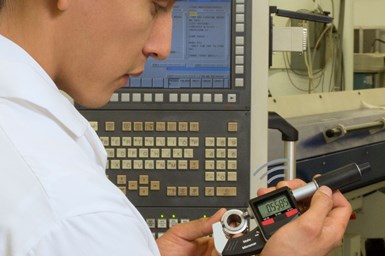What Manufacturers Need to Know About Metrology
As manufacturing technology advances, measurement processes evolve to stay one step ahead.
Share



Advancements in metrology for manufacturing in turn lead to process improvements in production.
Photo Credit: George Schuetz
Looking back over the past 50 years, there have been great advances in modern industrial production that provide greater precision and more reliable products. Whether it be automobiles, consumer electronics, medical or aviation, the fit, finishes, capabilities and reliability are truly incredible today with no sign that processes will become stagnant. There is a consistent drive to make things better, faster and with less cost.
The result of these manufacturing trends puts the same requirements on the measuring process. Measurement has had to evolve and stay ahead to meet newer, more stringent production demands. Because of this, we have seen great improvements in performance, ease of use for point-of-use inspection, data collection and a shift to many noncontact optical systems.
Much of this growth is reflected in the field of metrology. Metrology is a term and science that has become widely used in manufacturing and inspection industries, moving from early empirical controls to more scientifically-based dimensional measurements.
But what really is metrology? Metrology is the science of measurement aimed to establish a common understanding for many activities. It consists of several areas, but three main focuses are:
- The establishment of measurement standards that are both internationally accepted and defined
- The use of measuring equipment to correlate the extent that the product and process data conforms to specification
- The regular calibration of measuring equipment, traceable to international standards
All of these are dependent on measurement theory and making a measurement.
Often, one thinks only of the measurement result, usually a number and a unit (for example, 20 mm or 20⁰C). While this may provide a good start, it does not provide any information about how “good” the measurement itself may be. A measurement requires performing a certain process. To really define a measurement, one must know a number, the unit and the uncertainty of the measurement, as well as have traceability of the result to an international standard.
Let’s take a quick look at these four parts of the measurement process:
- The Number: This can be thought of as using a typical target image where one strives for accuracy (getting the correct value each time), repeatability (getting a consistent value) and precision (expressing the degree of repeatability of the measuring process).
- The Unit: Since this column is specific to manufacturing, we likely tend to think about dimensional length units. This comes from that first part of metrology: the establishment of measurement standards which are internationally accepted. These typically are based off a physical standard, such as the wavelength of light, and for us would be SI units (metric) or U.S. unit standards (inches).
- The Uncertainty: Measurement science is the study of measurement error — “E” — which is also known as Uncertainty. This error is thought to be comprised of different components of the total Uncertainty, with each contributing to variation in the measurement result. These variations are often broken down into two categories: those evaluated by statistical methods and those evaluated by other methods. For example, uncertainty errors can come from the environment, the measuring instrument, the user, the workpiece or the reference standard.
- The Traceability: The traceability of a measurement result is demonstrated by an unbroken chain of calibrations of the standards or equipment, with each contributing to the measurement uncertainty. Thus, for a traceable calibration of an instrument to be performed, one must have a traceable standard. The result is typically expressed with a deviation and the calibration uncertainty.
We have progressed from just a number and unit to understanding more about the measurement process. But there is even more information that should be considered as part of the data. There are new standards being introduced that require more parameters to be stored as part of the measurement results. These could include the time and date of the measurement, the operator and specifics about the instrument making the measurement — such as its model and serial number. With this information, one can defend that the part was measured, when and by whom as well as that the correct gage was used for the measurement, along with knowing its calibration and traceability information.
Just as production technology has improved, gaging metrology has had to stay one step ahead. There is a lot to learn about the measurement process and today, many are using metrology to keep process improvement moving forward.
Related Content
AI Creates CAD Files From Scan Data
While 3D visual scanners are useful, converting a visual scan to a usable CAD file can be a time-consuming process. With generative AI, it may be much simpler and faster.
Read MoreMore Surface Finish Parameters at Hand
Measuring surface finish at the point of manufacture is often done by the same machinist who is manufacturing the part. They need tools that meet test requirements and are easy to use.
Read MoreMeasuring Torque, Thrust Force for Smart Drilling Operations
To monitor drilling operations for smart manufacturing solutions, torque and thrust force can be measured.
Read MoreMarathon Precision’s Engineering Playground: One Shop’s Secret to Sustaining High Tech, Low-Volume and High Morale
Half an airplane on the wall, a ten-foot metal dragon, and a full-blown recording studio might not scream “manufacturing efficiency,” yet Marathon Precision proves otherwise. Here’s how forging, complex CNC operations and staff-driven creative projects combine to fuel the shop’s productivity and profitability.
Read More



















.png;maxWidth=300;quality=90)






